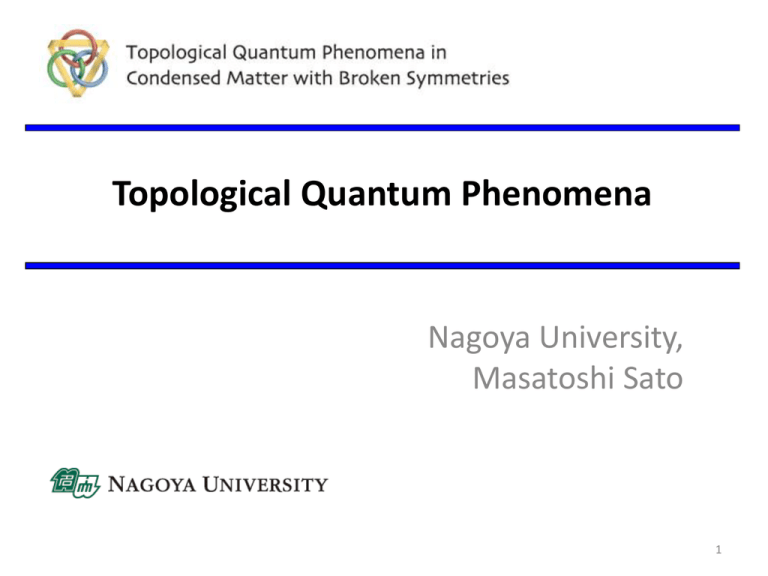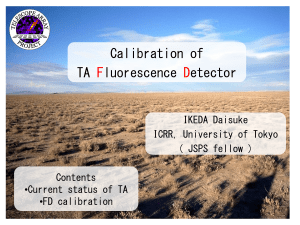スライドをダウンロードする - Nuclear Theory Group @ Univ. of Tokyo
advertisement

Topological Quantum Phenomena Nagoya University, Masatoshi Sato 1 In collaboration with • Satoshi Fujimoto (Kyoto University) • Yoshiro Takahashi (Kyoto University) • Yukio Tanaka (Nagoya University) • Keiji Yada (Nagoya University) • Ai Yamakage (Nagoya University) • Yuji Ueno (Nagoya University) • Takeshi Mizushima (Okayama University) • Kazushige Machida (Okayama University) • Masanori Ichioka (Okayama University) • Yasumasa Tsutsumi (Riken) • Takuto Kawakami (NIMS) • Ken Shiozaki (Kyoto University) • Shingo Kobayashi (Nagoya University) Review paper Y. Tanaka, MS, N. Nagaosa, “Symmetry and Topology in SCs” Journal of Physical Society of Japan, 81 (2012) 011013 (open access) 2 Outline Part 1. Topology in quantum mechanics 1. 2. 3. 4. Vortex and Quantum Hall state Topological insulators Topological superconductors Symmetry and topology Part 2. Symmetry protected topological phase 3 トポロジーとは 「形」が連続変形でつながるか、つながらないか マグカップ ≈ ドーナツ メビウスの輪 ボール ふつうの輪 4 量子力学のトポロジー 波動関数の「形」が連続変形でつながるか 例)磁束の量子化 磁場x 面積 磁束渦 超伝導渦の磁束量子 プランク定数 電子の電荷 ホログラフィー電子顕微鏡による磁束量子の観察 @日立 5 超伝導体状態の巨視的波動関数(クーパー対) 磁束渦あり 位相 𝜃が0 →2π 磁束渦なし 位相𝜃が 0 → 0 一般に波動関数の一意性から、位相𝜃の変化は2πN (N=0,1,2,..) 6 磁束の量子化 渦の中心から十分離れた領域では 超伝導電流 ベクトルポテンシャル アブリコソフ 𝑪 したがって Stokesの定理 位相変化が2πN 磁束 磁束がとびとびの値(N=0,1,2…)をとる 7 トポロジカル不変量 (連続変形で変わらない量) • トポロジーの違いを区別する便利な量 • トポロジカル不変量が違う場合は、波動関数の連続変形で移りあえない 𝑪 トポロジカル不変量 は、電荷、角運動量などと同じ保存量 量子化 8 例2)整数量子ホール効果 磁場 電場 2次元電子系 ホール電流 グラフェンの整数量子ホール効果 AlGaAs 14 GaAs ヘテロ接合 フォン・クリッツィング 10 グラフェン (単層カーボン) ホ ー 2 ル 伝 -2 導 率 -6 6 ホール伝導率 -10 -14 キャリア密度 9 磁場中の電子 一様磁場のベクトルポテンシャル 結晶構造による 周期ポテンシャル ブロッホの定理 中野(久保)公式 電流 10 TKNN(サウレス・甲元ら)公式 (1982) サウレス 甲元 チャーン数 (トポロジカル不変量) 占有バンドのベリー位相 運動量空間での”ベクトルポテンシャル” Nchは数学的な定理から整数値となる 11 占有バンドのトポロジー チャーン数 1 チャーン数 0 𝐸 𝐸 (𝑘𝑥 , 𝑘𝑦 ) 𝑢(𝑘) ≈ チャーン数は保存量 (𝑘𝑥 , 𝑘𝑦 ) 占有バンドの状態ベクトル 量子化 12 磁束の量子化 量子ホール効果 14 10 6 2 -2 -6 -10 -14 ホ ー ル 伝 導 率 キャリア密度 実空間 運動量空間 13 ノーベル賞 トポロジカル量子現象 1985 von Klitzing 整数量子ホール効果 1998 Laughlin, Störmer, Tsui 分数量子ホール効果 2003 Abrikosovら 超伝導・超流動の理論 脳磁図 量子化ホール抵抗による直流抵抗標準 定義 超伝導量子干渉計 フォン・クリッツィング定数 14 トポロジカルエッジ状態の発見 (2008 ~) トポロジカル絶縁体: 表面が金属となる絶縁体 角度分解型光電子分光 Bi1-xSbx 電子 Bi2Se3 光子 伝導帯 フェルミ準位 エ ネ ル ギ ー 表面状態 (eV) 価電子帯 波数(Å-1) 15 普通の絶縁体との違い トポロジカル絶縁体(TI) 𝐸 𝑢(𝑘) ≈ 普通の絶縁体 𝐸 • 価電子帯の電子のつまり方のトポロジーが普通の絶縁体と違う • 外部磁場がゼロであるため、量子ホール状態とも電子のつまり 方のトポロジーが違う (= トポロジカル不変量が違う) 16 トポロジカルエッジ状態 真空 (eV) トポロジカル絶縁体 ギ ャ ッ プ レ ス 状 態 エ ネ ル ギ ー 波数(Å-1) ひねり1 ひねり0 メビウスの輪 単なる輪 リボン 17 • 表面状態由来の特異な輸送現象を示す 例) 表面状態による純粋スピン流 エ ネ ル ギ ー (eV) 表面状態の電流は全体でゼロ しかし、スピン流は有限に残る 波数(Å-1) • 不純物の下でも安定 • 多数のトポロジカル絶縁体が発見されている Bi2Se3, Bi2Te3, TIBi(S1-xSex)2, Bi2Te2Se, (Bi1-xSbx)2(Te1-ySey)3, Pb(Bi1-xSbx)2Te4, ….. 18 Simplest model of TI = Massive Dirac Hamiltonian 𝜎𝜇 : Pauli matrices in orbital space (two pz-orbitals of Se) 𝑠𝜇 : Pauli matrices in spin space Bi2Se3 Topological # = Z2 invariant TR-invariant momentum occupied state 19 Surface bound state z Top.Insulator Dirac fermion It satisfies b.c if The surface state obeys 2+1 D Dirac equation 20 トポロジカルエッジ状態は超伝導体にも現れる トポロジカル超伝導体 超伝導体: クーパー対の形成 電子 ≈ クーパー対 ホール 基底状態では、フェルミエネルギー以下の状態が詰まっている 21 トポロジカル絶縁体と同様に、色々な「形」で状態をつめるやり方 がある。 𝑢(𝑘) ≈ トポロジカル不変量という「新しい保存量」を持つ超伝導状態 トポロジカル超伝導体 Qi et al, PRB (09), Schnyder et al PRB (08), 佐藤, PRB 79, 094504 (09), 佐藤・藤本, PRB79, 214526 (09) 22 トポロジカル超伝導体のトポロジカルエッジ状態 トポロジカル超伝導 ギ ャ ッ プ レ ス 状 態 真空 単なる輪 メビウスの輪 トポロジカル絶縁体 ギ ャ ッ プ レ ス 状 態 (eV) エ ネ ル ギ ー 波数(Å-1) 真空 23 Topological SCs/SFs T-breaking topological SC Energy Sr2RuO4 [Kashiwaya et al (11)] T-invariant topological SC 3He-B CuxBi2Se3 CuxBi2Se3 E chiral k [Murakawa, Nomura et al (09)] [Sasaki et al (09)] helical Experiment [Sasaki-Kriener-Segawa-YadaTanaka-MS –Ando (11)] [Fu-Berg (10)] CuxBi2Se3 Theory [MS (10)] [Yamakage-Yada-MS-Tanaka (12)] 24 S-wave SCs can host topological superconductivity if a spinless system is realized effectively • Dirac fermion + s-wave condensate • S-wave superconducting state with Rashba SO + Zeeman field [MS(03), Fu-Kane (08)] [MS-Takahashi-Fujimoto (09), J. Sau et al (10)] Hsieh et al Non spin-degenerate single Fermi surface Fermi Level MF Topolgiocal SC Zeeman field nanowire [Lutchyn et al (10), Oreg et al (10)] Zeeman field Zero modes [Mourik et al (12)] B 25 Why such new topological phases can be found ? The key is symmetry Time-reversal symmetry (TRS) Kramers theorem • No back scattering • topologically stable 26 Particle-hole symmetry (PHS) • Spectrum is symmetric between E and –E • Quasiparticles can be their own antiparticles Majorana condition 27 (09)] [Wilczek , Nature PH symmetry also provides topological stability nanowire PHS PHS • Single isolated zero mode is topologically stable due to PH symmetry • It realizes Majorana zero mode in condensed matter physics 28 Topological Periodic Table IQHS [Schnyder-Ryu-Furusaki-Ludwig (12)] [Avron-Seiler-Simon (83)] A AIII AI BDI D DIII AII CII C CI TRS PHS CS d=1 d=2 d=3 0 0 0 0 1 0 Z 0 Z 0 Z 0 0 Z Z2 Z2 0 2Z 0 0 0 0 Z Z2 Z2 0 2Z 0 1 1 0 -1 -1 -1 0 1 0 1 1 1 0 -1 -1 -1 0 1 0 1 0 1 0 1 0 Z Z2 Z2 0 2Z 0 0 Majorana nanowire p+ip chiral p Sr2RuO4, 3He-A 3He-B CuxBi2Se3 3D TI QSH Taking into account TRS, PHS and their combinations, nine new topological classes are found 29 Is there any possibility to extend topological phases by using other symmetries ? ex.) Inversion symmetry Topological Insulator [Fu-Kane (06)] Z2 number Inversion sym TR-invariant momentum occupied state • Non-local • Difficult to evaluate Bi1-xSbx Parity of occupied state • Local • Easy to evaluate 30 Topological odd parity SCs [MS (09, 10), Fu-Berg (10)] If the number of TRI momenta enclosed by the Fermi surface is odd, the spin-triplet SC is (strongly) topological. Even Odd (001) BW gap fn. Majorana fermion (001) CuxBi2Se3 31 However, inversion symmetry gives no additional gapless surface state beyond the topological periodic table Broken on surface bulk-edge correspondence New bulk top. # by inversion No additional state Idea If we use symmetry that is not broken near the surface, we can obtain new gapless states beyond the topological periodic table Symmetry Protected Topological Surface State 32 Topological Crystalline Insulator [L. Fu (11), Hsieh et al (12)] Point group symmetry provide a topological surface state beyond topological periodic table SnTe (110) Mirror reflection surface BZ BZ 33 Idea Using the eigen value of mirror operator, ky=0 plane can be separated into two QH states. Two Dirac fermions [Y. Tanaka et al (12) ] Not ordinal TI (Top Crystalline Insulator)34 Question Can we generalize the same idea to obtain new topological SCs ? YES Majorana fermions protected by additional symmetry 35 Symmetry Protected Majorana fermions • • • • • MS, Fujimoto, Phys. Rev. B 79, 094504 (09) Mizushima, MS, Machida, Phys. Rev. Lett. 109, 165301 (12) Mizushima, MS, New J. Phys. 15, 075010 (13) Ueno, Yamakage, Tanaka, MS, Phys. Rev. Lett. 111, 087002 (13) MS, Yamakage, Mizushima, arXiv: 1307.1264, invited paper in Physica E • • • • Chui-Yao-Ryu, Phys. Rev. B88, 074142 (13) Zang-Kane-Mele, Phys. Rev. Lett. 111, 056403 (13) Morimoto-Furusaki, arXiv: 1306.2505 Fang-Gilbert-Bernevig, arXiv:1308.2424 36 Now we know that MFs can be realized in SCs. But spinless systems are often needed to realized MFs. Hsieh et al Dirac fermion + s-wave condensate MS(03), Fu-Kane (08) S-wave superconducting state with Rashba SO + Zeeman field MS-Takahashi-Fujimoto (09), J. Sau et al (10) Non spin-degenerate single Fermi surface Fermi Level Zeeman field MF nanowire Zeeman field Mourik et al (12) Lutchyn et al (10), Oreg et al (10) 37 Why Majorana Fermions favor spinless SCs ? For spinless SCs, we have the Majorana condition (self-antiparticle property) naturally. However, the spin degrees of freedoms obscure the Majorana condition Nitta, JPSJ talk Majorana condition Majorana condition 38 Moreover, spinful SCs support MFs in pairs because of the spin degeneracy. They can be considered as Dirac fermions as well as MFs The Dirac fermions are easily gapped away by the Dirac mass term No topologically stable MFs 39 Question Is it possible to realize Majorana fermions in spinful SCs ? Key observation If there is an additional symmetry such as time-reversal symmetry, Majorana fermions can be realized in spinful SCs Sasaki-Kriener-SegawaYada-Tanaka-MS -Ando(11) CuxBi2Se3 Fu-Berg (10) CuxBi2Se3 Yamakage--Yada-MS-Tanaka(12) MS (10) 40 Ex.) 1D spinful px-wave superconductor A pair of MFs px-wave SC Kramers theorem No scattering between and Thus, they naturally can be considered as two independent particles, not as a single Dirac fermion. Actually, the Dirac mass term is forbidden by the time-reversal symmetry. Topologically stable MF 41 Can we use symmetries other than time-reversal symmetry? Topological crystalline SC Ueno-Yamakage-Tanaka-MS (13) Chui-Yao-Ryu (13) Zhang-Kane-Mele (13), … 42 Topological Crystalline SCs [Ueno, Yamakage, Tanaka, MS (13)] mirror reflection symmetry Sr2RuO4 UPt3 BZ 43 Like topological crystalline insulators, kz=0 plane can be separated into two mirror subsectors mirror Chern # for Mxy=i mirror Chern # for Mxy=-i When the mirror Chern numbers are nonzero, we have gapless surface states 44 However, there is an important difference between TCIs and TCSCs Particle-hole symmetry = Majorana condition PH symmetry The problem is how the particle-hole symmetry is realized in the mirror subsectors. 45 Key point Two different mirror symmetries are possible in SCs. a) S-wave SC Spin-triplet SC with 𝒅 ∥ 𝒛 U(1) gauge sym b) Spin-triplet SC with 𝒅 ⊥ 𝒛 46 Even Class A Class A Dirac fermion • Mirror subsector does not support its own particle-hole symmetry. • Mirror subsector is topologically the same as quantum Hall states. 47 Odd Class D Class D Majorana fermion • Mirror subsector supports its own particle-hole symmetry . • Mirror subsector is topologically the same as spinless SCs. • Majorana zero mode can exit in a vortex or in a dislocation Schnyder et al (08) Teo-Kane (10) class D 1D Z2 2D Z 3D - 48 Stable MFs are predicted for various spinful SCs/SFs • Sr2RuO4 [Ueno, Yamakage, Tanaka, MS (13)] • Thin film of 3He-A • UPt3 [MS, Yamakage, Mizushima (13)] [Tsutsumi-Yamamoto-Kawami-Mizushima-MS-Ichioka-Machida (13)] integer vortex [MS, Yamakage, Mizushima (13)] 3He-A LDOS at core of integer vortex Majorana zero modes exist in integer vortex when mirror odd 49 Summary (1) 1. In general, spinful SCs support a pair of Majorana fermions that can be identified with a single Dirac fermion. 2. With symmetry, unconventinal spinful SCs can host intrinsic Majorana fermions In particular, a pair of Majorana zero modes in a vortex can be stable by additional SCs Is it possible to generalize topological periodic table with additional symmetry ? 50 Topological Periodic Table with Mirror Symmetry 10 classes 27 classes [Chui-Yao-Ryu, PRB(13) , Morimoto-Furusaki, PRB (13)] MF protected by mirror symmetry Sr2RuO4, UPt3 Topological crystalline insulator SnTe Still not enough ….. 51 There are many symmetries other than mirror reflection spin-flip, mirror reflection, rotation, inversion ….. Unitary symmetry magnetic point group, hidden time-reversal symmetry Anti-unitary symmetry 52 Anti-Unitary case Anti-unitary symmetries are often realized as a hidden timereversal symmetry Time-reversal + Mirror reflection magnetic field T-invariant Hidden time-reversal symmetry These hidden time-reversal symmetries also provide symmetry protected MFs 53 Using the hidden time-reversal symmetry, we can define a new topological number Combining with particle-hole symmetry, we obtain chiral symmetry Then, we can define new topological number New topological phase MS-Fujimoto (09) 54 MFs protected by the hidden time-reversal symmetry can be found in various system under magnetic fields • Rashba SC under magnetic filed [MS-Fujimoto (09), Tewari-Sau (12), Wong-Liu-Law-Lee(13), Mizushima-MS (13), Zhang-Kane-Mele (13)] nanowire MF Hx • 3He-B s-wave Rashba SF tubes under parallel filed [Mizushima-MS-Machida (12) ] 𝜋 Topological QPT with SSB Hy ● 3He-B 55 New Topological Periodic Tables [Shiozaki-MS, in preparation (14)] We have complete the topological classification with order-two additional symmetry 10 classes [Schnyder et al (08)] Hx 27 classes [Chui-Yao-Ryu (13) , Morimoto-Furusaki (13)] (27+10)x4=148 classes [Shiozaki-MS (14)] 56 Summary • The idea of topological phase has been established now with many experimental supports. • While time-reversal invariance and particle-hole symmetry has been used to extend topological phase, other symmetries specific to material structures are also useful to have new topological phases. • Many undiscovered topological materials can be expected by combining various symmetries in nature. 57
